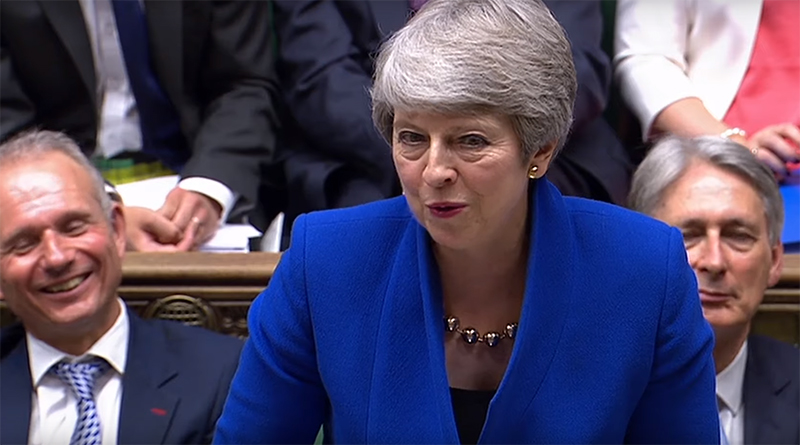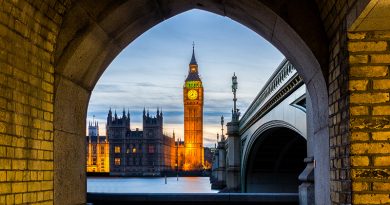Theresa May and press coverage
As I watched Theresa May’s final Prime Minister’s Questions on Wednesday I was struck by how hypocritical Parliament can be. PMQ’s usually demonstrates how base, childish and tribal our political system sometimes is. But here we had something else. I’m all for good manners, but there was something tawdry about the standing ovation and Jacob Rees – Mogg’s words about service and courtesy. Remember that this a colleague who has devoted himself to engineering the PM’s departure.
So when May left Downing Street in the Prime Ministerial car for the last time we can assume that she reflected on her time in office with some regret and perhaps great relief that her ordeal was finally over. Most political commentators, of all political persuasions, were united in criticism of her tenure. Last week Gary Younge wrote in the Guardian that she was “ineffectual” and that, “her shortcomings are many and her failures in office were self-evident.” She was “hopeless” continued Younge and “deserved no pity”. In March, the Sun’s long term political analyst, Trevor Kavanagh wrote, “ there is no doubt she brought this crisis and ¬turmoil upon her own head and upon the country”.
In truth, May’s relationship with the media has been, at best, fractious. In her leadership campaign in 2016, she made great virtue of the fact that she was not like other candidates. As the Politico website reported her saying: “I don’t tour the television studios. I don’t gossip about people over lunch. I don’t go drinking in parliament’s bars.”
Throughout her career she has made little attempt to develop allies or cultivate friends in the press. She has preferred to instead to rely on her studied aloofness and single minded sense of purpose. In the immediate aftermath of the Cameron years, this attitude was welcomed as refreshing – though it didn’t survive the realities of being a Prime Minister.
When she visited New York in late September 2016 (mere months after becoming prime minister) she found time in her hectic 36-hour schedule to meet with Rupert Murdoch.
Perhaps, as The Guardian hinted, the previously media reticent May was just performing a realpolitik quid pro quo because in the Conservative leadership battle Murdoch’s Sun had backed her and Michael Gove – instead of, as had been expected, prioritising Gove as a former News UK employee. She was to learn very quickly, if she didn’t know already, that loyalty from the press was always going to be a one way street.
On the whole, though, it is interesting and dispiriting to note that, as with every other female politician in the country, May’s political career has been predominantly defined by her gender. As I’ve written before, in 2015, as Home Secretary, her appearance in Parliament on Budget day threatened to overshadow the Chancellor’s statement. In the Daily Mail , sketch writer Quentin Letts recorded that (note familiar use of first name): “Theresa sat in a suit so low cut she could have been taken for Sam Fox”. An accompanying picture illustrated his point.
When May became only the second female Prime Minister in British history, much of the media coverage focused on her gender and on her reported fetish for footwear.
For the Sun , she was the shoe fanatic whose childhood dream was to be a politician, bringing the men “to heel”. Goody Two Shoes said the Mirror . Theresa’s fancy footwork gets her the job, said the Daily Star . This sort of coverage became mundane and day to day. As Guto Harri wrote in GQ magazine in 2018, “Theresa May gets three times as many comments on her appearance as Jeremy Corbyn”
Then there were the inevitable comparisons with Margaret Thatcher which led columnist Hadley Freeman to wittily point out that : “women are such rare creatures that they can only be understood through the prism of one another, like unicorns or sporting triumphs by the England football team.”
Such stuff has continued up to and during her resignation period. On the eve of her departure announcement, the Metro newspaper (which is due to its availability and no cost is perhaps the most widely read newspaper in the UK at the moment) led with the front page picture story, “JUST TELL HER, PHIL” which echoed the supposed wishes of the Tory party. This of course reinforces the traditional patriarchal view – this uppity woman has had her time and chance. It’s time for the husband to reassert his authority and put his wife back in the box.
In the end May embodied the classic contradictions of ‘gendered mediation’. In order to succeed at the highest level in politics women have to, in the words of Blair Williams, adhere to the stereotypically masculine behavioural norms of politics. But when that happens they are portrayed as aggressive or unnatural. As Williams says, the double bind is when women act as ‘too feminine’ then they are “weak, overly emotional” and therefore not to be fully trusted.
The issue that disturbs journalist Sarah Shaffi the most is that the discussions about May’s femininity occupy the space in which there could be a more serious dissection of her party’s policies and their effects. What about Windrush, continuing austerity, US – UK relations in the age of Trump?
So, we’re in another new era with the barely credible Boris Johnson, whose relentless, unfounded optimism is being leapt upon by certain politicians and members of the press as the best hope we’ve got. There is not the slightest evidence that Johnson can apply himself to the complexities of Brexit negotiations or the myriad of other problems that the UK faces. But, at the moment, the bastions of the right wing British press support him. This Sunday’s Sun stated: “From Day One, BoJo must deploy his trademark can-do optimism to lift his party and country, and show he is the right leader to overcome the crises he inherited.”
Well, one thing is for sure: if he doesn’t deliver, history tells us that his current supporters may vanish quicker than a Labrador’s breakfast.



